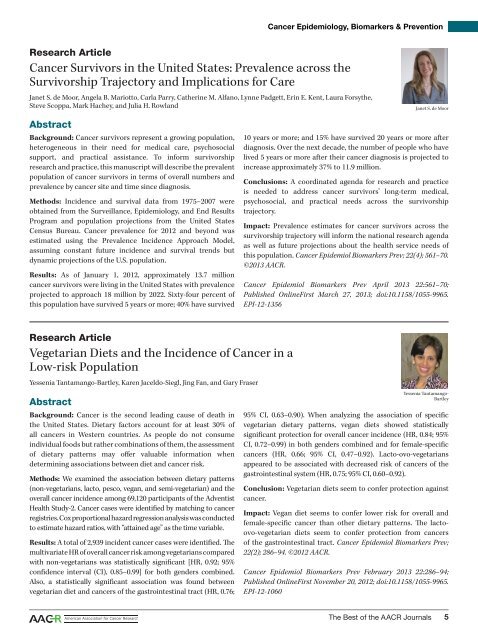Best of AACR Journals
Create successful ePaper yourself
Turn your PDF publications into a flip-book with our unique Google optimized e-Paper software.
Cancer Epidemiology, Biomarkers & Prevention<br />
Research Article<br />
Cancer Survivors in the United States: Prevalence across the<br />
Survivorship Trajectory and Implications for Care<br />
Janet S. de Moor, Angela B. Mariotto, Carla Parry, Catherine M. Alfano, Lynne Padgett, Erin E. Kent, Laura Forsythe,<br />
Steve Scoppa, Mark Hachey, and Julia H. Rowland<br />
Janet S. de Moor<br />
Abstract<br />
Background: Cancer survivors represent a growing population,<br />
heterogeneous in their need for medical care, psychosocial<br />
support, and practical assistance. To inform survivorship<br />
research and practice, this manuscript will describe the prevalent<br />
population <strong>of</strong> cancer survivors in terms <strong>of</strong> overall numbers and<br />
prevalence by cancer site and time since diagnosis.<br />
Methods: Incidence and survival data from 1975–2007 were<br />
obtained from the Surveillance, Epidemiology, and End Results<br />
Program and population projections from the United States<br />
Census Bureau. Cancer prevalence for 2012 and beyond was<br />
estimated using the Prevalence Incidence Approach Model,<br />
assuming constant future incidence and survival trends but<br />
dynamic projections <strong>of</strong> the U.S. population.<br />
Results: As <strong>of</strong> January 1, 2012, approximately 13.7 million<br />
cancer survivors were living in the United States with prevalence<br />
projected to approach 18 million by 2022. Sixty-four percent <strong>of</strong><br />
this population have survived 5 years or more; 40% have survived<br />
10 years or more; and 15% have survived 20 years or more after<br />
diagnosis. Over the next decade, the number <strong>of</strong> people who have<br />
lived 5 years or more after their cancer diagnosis is projected to<br />
increase approximately 37% to 11.9 million.<br />
Conclusions: A coordinated agenda for research and practice<br />
is needed to address cancer survivors’ long-term medical,<br />
psychosocial, and practical needs across the survivorship<br />
trajectory.<br />
Impact: Prevalence estimates for cancer survivors across the<br />
survivorship trajectory will inform the national research agenda<br />
as well as future projections about the health service needs <strong>of</strong><br />
this population. Cancer Epidemiol Biomarkers Prev; 22(4); 561–70.<br />
©2013 <strong>AACR</strong>.<br />
Cancer Epidemiol Biomarkers Prev April 2013 22:561–70;<br />
Published OnlineFirst March 27, 2013; doi:10.1158/1055-9965.<br />
EPI-12-1356<br />
Research Article<br />
Vegetarian Diets and the Incidence <strong>of</strong> Cancer in a<br />
Low-risk Population<br />
Yessenia Tantamango-Bartley, Karen Jaceldo-Siegl, Jing Fan, and Gary Fraser<br />
Abstract<br />
Background: Cancer is the second leading cause <strong>of</strong> death in<br />
the United States. Dietary factors account for at least 30% <strong>of</strong><br />
all cancers in Western countries. As people do not consume<br />
individual foods but rather combinations <strong>of</strong> them, the assessment<br />
<strong>of</strong> dietary patterns may <strong>of</strong>fer valuable information when<br />
determining associations between diet and cancer risk.<br />
Methods: We examined the association between dietary patterns<br />
(non-vegetarians, lacto, pesco, vegan, and semi-vegetarian) and the<br />
overall cancer incidence among 69,120 participants <strong>of</strong> the Adventist<br />
Health Study-2. Cancer cases were identified by matching to cancer<br />
registries. Cox proportional hazard regression analysis was conducted<br />
to estimate hazard ratios, with “attained age” as the time variable.<br />
Results: A total <strong>of</strong> 2,939 incident cancer cases were identified. The<br />
multivariate HR <strong>of</strong> overall cancer risk among vegetarians compared<br />
with non-vegetarians was statistically significant [HR, 0.92; 95%<br />
confidence interval (CI), 0.85–0.99] for both genders combined.<br />
Also, a statistically significant association was found between<br />
vegetarian diet and cancers <strong>of</strong> the gastrointestinal tract (HR, 0.76;<br />
Yessenia Tantamango-<br />
Bartley<br />
95% CI, 0.63–0.90). When analyzing the association <strong>of</strong> specific<br />
vegetarian dietary patterns, vegan diets showed statistically<br />
significant protection for overall cancer incidence (HR, 0.84; 95%<br />
CI, 0.72–0.99) in both genders combined and for female-specific<br />
cancers (HR, 0.66; 95% CI, 0.47–0.92). Lacto-ovo-vegetarians<br />
appeared to be associated with decreased risk <strong>of</strong> cancers <strong>of</strong> the<br />
gastrointestinal system (HR, 0.75; 95% CI, 0.60–0.92).<br />
Conclusion: Vegetarian diets seem to confer protection against<br />
cancer.<br />
Impact: Vegan diet seems to confer lower risk for overall and<br />
female-specific cancer than other dietary patterns. The lactoovo-vegetarian<br />
diets seem to confer protection from cancers<br />
<strong>of</strong> the gastrointestinal tract. Cancer Epidemiol Biomarkers Prev;<br />
22(2); 286–94. ©2012 <strong>AACR</strong>.<br />
Cancer Epidemiol Biomarkers Prev February 2013 22:286–94;<br />
Published OnlineFirst November 20, 2012; doi:10.1158/1055-9965.<br />
EPI-12-1060<br />
The <strong>Best</strong> <strong>of</strong> the <strong>AACR</strong> <strong>Journals</strong> 5



